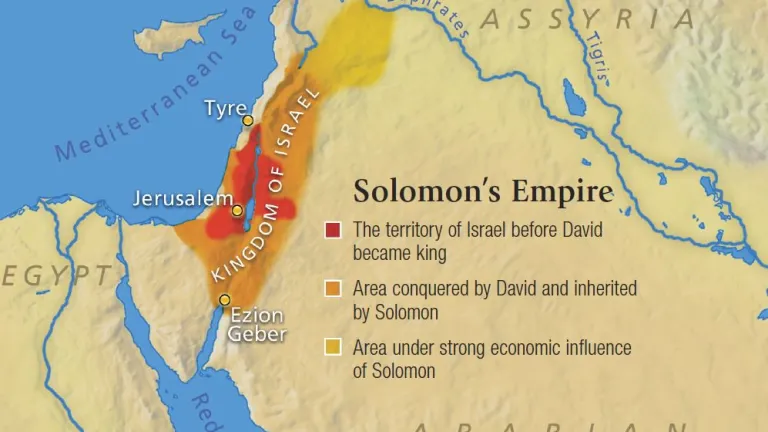2 Chronicles 8 and Related
Gift exchange between Solomon and Hiram, Solomon's other works
Solomon's Other Works
Solomon's other works consisted largely of building projects in various cities, securing Israel's frontiers and building an institutionalized army. He seized Hamath Zobah, a region on Israel's northeast border containing two cities, Hamath and Zobah, the former of which had formerly been friendly with David but now, given its association with Zobah, had probably switched allegiance. He built Tadmor in the wilderness (called by the Romans Palmyra) in a fertile oasis just to the southeast of Zobah. He built Hazor in northern Israel upon the high ground overlooking Lake Merom. He rebuilt Gezer in Ephraim, which had been attacked and burned by Pharaoh, its Canaanite inhabitants exterminated, and then given to his daughter as a gift upon her marriage to Solomon. He rebuilt upper and lower Beth Horon, two cities located in Ephraim and separated by about two miles. He refortified Baalath in Dan. And he rebuilt or fortified Megiddo, which occupied a strategic position on the Plain of Esdraelon on the border of Issachar and Mannaseh. As may be seen from the list of localities, Solomon directed his attention to securing Israel's northern borders. This is also evidence that tends to confirm our understanding of Solomon's marriage with the daughter of Pharaoh as an alliance with Egypt to diminish or eliminate a threat from Israel's south.
In addition, Solomon built the Millo, apparently a landfill between Mount Zion and Mount Moriah, thereby reducing the valley between the two prominences. And he greatly extended the wall of Jerusalem, finally fully enclosing both the lower city and the upper city.
As is well known, Israel did not exterminate all the gentile inhabitants of the land when Joshua brought Israel across Jordan. These people continued to live in the land. Solomon conscripted these peoples into forced labor for his many building projects.
Additionally, Solomon brought the daughter of Pharaoh into her new residence. Formerly she had dwelt in the lower city of Jerusalem, but not in the house of David for, since the Ark of the Covenant had been there, Solomon felt that this gentile woman's presence in a place hallowed by the ark would have been unacceptable. This is evidence that the daughter of Pharaoh was not fully converted to the worship of God, otherwise she would have been esteemed an Israelite and able to partake of all the privileges of an Israelite. Her presence would not have been defiling.
Solomon also installed the system of worship that David had defined for the temple. The priesthood served by courses assigned to the major houses of the sons of Aaron. The proper sacrifices were offered on all the days observed by Israel—weekly Sabbaths, monthly new moons, and annual feasts. Thus was everything set in its place for the continual and orderly worship of God in His temple.
The final record in this section concerns the ports of Ezion Geber near Elath on Israel's extreme southeastern border upon the "Red Sea"—actually the Gulf of Aqaba, a "finger" of the Red Sea. Here a fleet of ships was built and manned under a joint venture between Solomon and Hiram. This southern seaport would serve as Israel's major port of entry and the point of departure for Ophir (the location of which is still in dispute). Such southern trade was extremely lucrative, and the fact that the Phoenician Hiram, king of Tyre, was engaged with Solomon at this port far removed from Tyre is one more piece of evidence that Israel was far from a landlocked little country notable only for its preoccupation with monotheism, as some scholars habitually picture it. Israel was in alliance with the Phoenicians, and the worldwide trading empire we know as the Phoenician Empire was at that time actually an Israelite-Phoenician union.
Interestingly, as pointed out previously in the Beyond Today Bible Commentary on Exodus 13:17-14:30, the Hebrew term translated "Red Sea" in verse 26 is Yam Suf (supposedly literally "Sea of Reeds")—the same name given in the book of Exodus to the body of water that Moses and the Israelites crossed. The fact that a finger of the Red Sea could bear this name disproves the idea taught by many that Yam Suf must refer to a swamp or marshy lake with reed plants like cattails, rushes and papyrus. Evidently, Yam Suf can also mean "Sea of Seaweed," as suf obviously means seaweed in Jonah 2:5.





Beyond Today Bible Commentary: 2 Chronicles